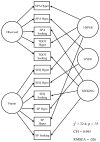Differential associations between sensory response patterns and language, social, and communication measures in children with autism or other developmental disabilities
- PMID: 21862675
- PMCID: PMC3325756
- DOI: 10.1044/1092-4388(2011/10-0029)
Differential associations between sensory response patterns and language, social, and communication measures in children with autism or other developmental disabilities
Abstract
Purpose: To examine patterns of sensory responsiveness (i.e., hyperresponsiveness, hyporesponsiveness, and sensory seeking) as factors that may account for variability in social-communicative symptoms of autism and variability in language, social, and communication skill development in children with autism or other developmental disabilities (DDs).
Method: Children with autistic disorder (AD; n = 72, mean age = 52.3 months) and other DDs (n = 44, mean age = 48.1 months) participated in a protocol measuring sensory response patterns; social-communicative symptoms of autism; and language, social, and communication skills.
Results: Hyporesponsiveness was positively associated with social-communicative symptom severity, with no significant group difference in the association. Hyperresponsiveness was not significantly associated with social-communicative symptom severity. A group difference emerged for sensory seeking and social-communicative symptom severity, with a positive association for the AD group only. For the 2 groups of children combined, hyporesponsiveness was negatively associated with language skills and social adaptive skills. Sensory seeking also was negatively associated with language skills. These associations did not differ between the 2 groups.
Conclusions: Aberrant sensory processing may play an important role in the pathogenesis of autism and other DDs as well as in the rate of acquisition of language, social, and communication skills.
Figures
Similar articles
-
Brief report: The relationship between language skills, adaptive behavior, and emotional and behavior problems in pre-schoolers with autism.J Autism Dev Disord. 2012 Dec;42(12):2761-6. doi: 10.1007/s10803-012-1534-8. J Autism Dev Disord. 2012. PMID: 22527707
-
Hyporesponsiveness to social and nonsocial sensory stimuli in children with autism, children with developmental delays, and typically developing children.Dev Psychopathol. 2013 May;25(2):307-20. doi: 10.1017/S0954579412001071. Dev Psychopathol. 2013. PMID: 23627946 Free PMC article.
-
Exploring cascading effects of sensory processing on language skills and social-communicative difficulties through play in young children at elevated likelihood for autism.Infancy. 2025 Jan-Feb;30(1):e12625. doi: 10.1111/infa.12625. Epub 2024 Oct 9. Infancy. 2025. PMID: 39382140
-
Input and language development in children with autism.Semin Speech Lang. 2013 Nov;34(4):237-48. doi: 10.1055/s-0033-1353446. Epub 2013 Dec 2. Semin Speech Lang. 2013. PMID: 24297616 Review.
-
Autistic children: diagnosis and clinical features.Pediatrics. 1991 May;87(5 Pt 2):751-60. Pediatrics. 1991. PMID: 1708491 Review.
Cited by
-
The relationship between sensory experiences and social functioning in children with autism spectrum disorder.Int J Dev Disabil. 2022 Oct 4;70(4):632-640. doi: 10.1080/20473869.2022.2128553. eCollection 2024. Int J Dev Disabil. 2022. PMID: 38983486 Free PMC article.
-
Activity Participation and Sensory Features Among Children with Autism Spectrum Disorders.J Autism Dev Disord. 2015 Sep;45(9):2981-90. doi: 10.1007/s10803-015-2460-3. J Autism Dev Disord. 2015. PMID: 25975628 Free PMC article.
-
The Relationship Between Clinical Presentation and Unusual Sensory Interests in Autism Spectrum Disorders: A Preliminary Investigation.J Autism Dev Disord. 2013 Jun 25. doi: 10.1007/s10803-013-1867-y. Online ahead of print. J Autism Dev Disord. 2013. PMID: 23797714
-
Sensory Profiles in Relation to Later Adaptive Functioning Among Toddlers at High-Familial Likelihood for Autism.J Autism Dev Disord. 2024 Jun;54(6):2183-2197. doi: 10.1007/s10803-022-05869-5. Epub 2023 Apr 5. J Autism Dev Disord. 2024. PMID: 37017863 Free PMC article.
-
Exploring the Usefulness of a Multi-Sensory Environment on Sensory Behaviors in Children with Autism Spectrum Disorder.J Clin Med. 2024 Jul 16;13(14):4162. doi: 10.3390/jcm13144162. J Clin Med. 2024. PMID: 39064201 Free PMC article.
References
-
- Adamson A, O’Hare A, Graham C. Impairments in sensory modulation in children with autism spectrum disorder. British Journal of Occupational Therapy. 2006;69:357–364.
-
- American Psychiatric Association. Diagnostic and statistical manual of mental disorders. 4. Washington, DC, US: American Psychiatric Publishing, Inc; 2000. text revision; DSM-IV-TR.
-
- Ashburner J, Ziviani J, Rodger S. Sensory processing and classroom emotional, behavioral, and educational outcomes in children with autism spectrum disorder. American Journal of Occupational Therapy. 2008;62:564–573. - PubMed
-
- Bailey A, Phillips W, Rutter M. Autism: Towards an integration of clinical, genetic, neuropsychological, and neurobiological perspectives. Journal of Child Psychology and Psychiatry. 1996;37(1):89–126. - PubMed
-
- Baranek GT. Unpublished manuscript. University of North Carolina; Chapel Hill: 1998. Tactile Defensiveness and Discrimination Test-Revised (TDDT-R)
Publication types
MeSH terms
Grants and funding
LinkOut - more resources
Full Text Sources
Medical


